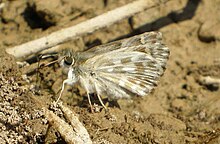Carcharodus baeticus
| Carcharodus baeticus | ||||||||||||
|---|---|---|---|---|---|---|---|---|---|---|---|---|

Carcharodus baeticus |
||||||||||||
| Systematics | ||||||||||||
|
||||||||||||
| Scientific name | ||||||||||||
| Carcharodus baeticus | ||||||||||||
| ( Rambur , 1842) |
Carcharodus baeticus is a butterfly from the family of the thick-headed butterflies (Hesperiidae).
features
The fore wing length is 13 to 14 millimeters. The top of the forewings is marbled gray and slightly dark gray-brown. Furthermore, a narrow, gray discal band delimits the darker basal region, and there are small hyaline spots on the forewing. The upper side of the hind wing is dark brown with a small, light basal spot and pronounced discal and postdiscal spots as well as a large discoid spot. The underside of the forewings is gray-brown with light-colored veins. The hind wing underside is light yellow-gray with white veins, basal and discal spots and post-discal moons. Overall, they create a network-like pattern. Both sexes have the same wing markings, the male has strong hair growth on the underside of the forewings.
variability
The 1st generation is generally dark gray, the 2nd generation light gray and the 3rd generation light sand brown. The hair growth in butterflies is dark in early summer and light sandy brown in later flying animals.
Geographical occurrence and habitat
Carcharodus baeticus occurs in large parts of the Iberian Peninsula (with the exception of the north and west coast), on the French Mediterranean coast and isolated in Valais (Switzerland), Piedmont (northern Italy), Apennines (central Italy) and Sicily . The moth can be found on dry, warm slopes with little vegetation up to 1600 meters.
Way of life
The moths fly in two to three generations from May to October. Only one generation occurs in higher altitudes or in the northern part of the distribution area (e.g. Switzerland). The caterpillar lives on the common horehound ( Marrubium vulgare ) and black nettles ( Ballota ).
Systematics
Carcharodus baeticus was first scientifically described by Jules Pierre Rambur in 1842 as Spilothyrus baeticus . The type locality is Andalusia . A more recent synonym is Carcharodus marrubii ( Rambur 1842).
swell
literature
- Lionel G. Higgins and Norman D. Riley: The Butterflies of Europe and Northwest Africa . Paul Parey Publishing House, Hamburg and Berlin 1978, ISBN 3-490-01918-0 .
- Tom Tolman, Richard Lewington: The butterflies of Europe and Northwest Africa . Franckh-Kosmos, Stuttgart 1998, ISBN 3-440-07573-7 .
Individual evidence
- ↑ on the spelling of the species name, see also the article by Ernst Brockmann in the Lepiforum [1]
- ^ A b c Lionel G. Higgins and Norman D. Riley: The butterflies of Europe and Northwest Africa . P. 291
- ↑ After Wolfgang Wagner this population has died out
- ↑ a b c Tolman & Lewington (1998: p. 265)
- ↑ The species was described by Heppner in 1842; after John B. Heppner: Dates of Selected Lepidoptera Literature for the Western Hemisphere. Journal of the Lepidopterists Society, 36 (2): 87-111, New Haven 1982 PDF ( page no longer available , search in web archives ) Info: The link was automatically marked as broken. Please check the link according to the instructions and then remove this notice.
Web links
- Lepiforum e. V. Taxonomy and Photos
- Art portrait at pyrgus.de
- Moths and Butterflies of Europe and North Africa (English)
- eurobutterflies.com (English)
- Carcharodus baeticus at Fauna Europaea
- Carcharodus baeticus inthe IUCN 2013 Red List of Threatened Species . Posted by: van Swaay, C., Wynhoff, I., Verovnik, R., Wiemers, M., López Munguira, M., Maes, D., Sasic, M., Verstrael, T., Warren, M. & Settele, J., 2009. Retrieved January 21, 2014.
